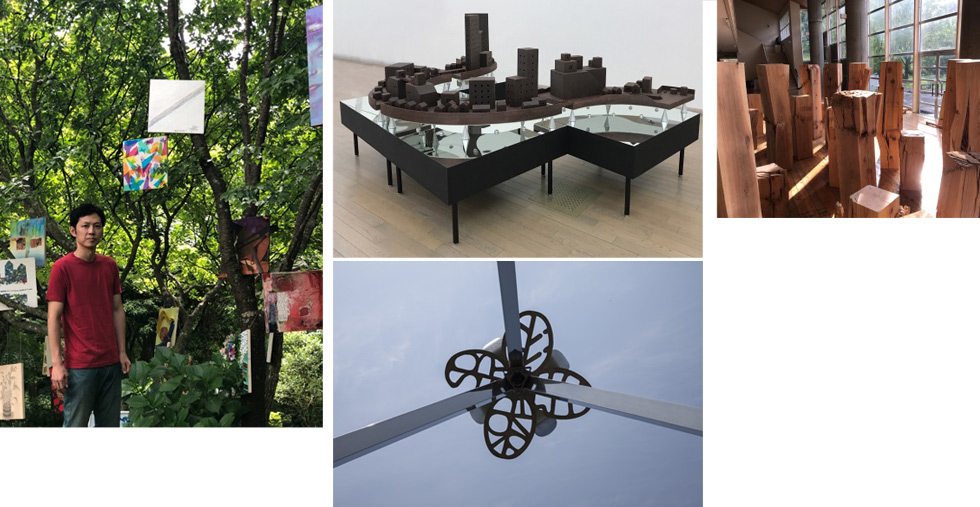Home > User’s voice > Sculptor | Mr. Takaya Mori
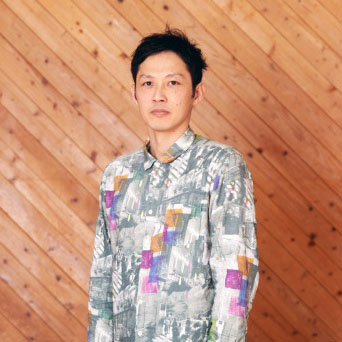
SculptorMr. Takaya Mori
"Respect towards the forces of nature that transcend our knowledge/Titanium as a medium for expression"
Sculptor
Mr. Takaya Mori
1981 Born in Tamana City, Kumamoto Prefecture, he currently resides in Taketa City, Oita Prefecture.
He conducted solo exhibitions, group exhibitions, workshops, lectures, and other activities.
2005 Graduated with a Major in Art Education at the Faculty of Education, Oita University Graduate School of Education
2012 Received the grand prize at the 11th Oita Asian Sculpture Exhibition (the first ever for an artist from Oita Prefecture)
2013 Received the UBE Materials Award at the 25th UBE Biennale (currently the International Sculpture Competition)
2015 Participated in the Oita Arts and Culture Promotion Council Overseas Program (New York)
2017 Participated in the 2016–2017 Bungotakada City Arts and Flower Cape Development Project (installed two outdoor sculptures at Nagasakibana)
2017 Received the Kohdo Art Award (grand prize) at the 72nd Kohdo Art Exhibition
2018 Started the ongoing "Kibaru Project" with cooperation from Nippon Bunri University, renovating vacant houses in the Kibaru region in Taketa City into art studios and residential spaces.
2019 Launched the "Titanium Project" at the end of the year, using the designing titanium TranTixxii brand to promote Japan's beautiful titanium to the world
Reference
One outdoor sculpture at the Oita Art Museum
One outdoor (group-made) sculpture, two indoor sculptures at the ASAKURA Museum of Sculpture
Two outdoor sculptures at Bungotakada City Nagasakibana
One outdoor sculpture at GLANZ TAKETA
1. Introduction
I moved to Oita Prefecture when I enrolled in university, and fell in love with Taketa City with its deep mountains, abundant water, and nature. The area is near the prefectural borders of Kumamoto, and I decided to establish my creative base here.
I studied art at the faculty of education at university, and focused on studying the basics of art.
Looking back, I was a graduate student when I started on my path toward becoming a genuine sculptor. It all sparked off back when I received an award in a sculpture contest and was enjoying the party after the event ceremony. The organizers' representative asked everyone if they imagined themselves to be still active after reaching their 80s. The winners of the grand prize immediately answered, "Of course!" but I was not so sure myself. I felt frustrated at my lack of determination, and this emotion served as the driving force in my decision to become a sculptor.
Although I studied a broad range of topics in art at university, there was a limit to what I could learn about sculptures, as it was not an art college. I was very much aware of my lack of experience as a sculptor. That is why after graduating, I entered an iron works and worked part-time for about four years while learning about metal processing techniques from the experts.
Thanks to this experience, I was able to build up my experience a little at a time, going on to receive awards at Asian and international sculpting competitions. I used to release my artwork only in the Kyushu region when starting out, but now I am fortunate to have opportunities for holding exhibitions in Tokyo or even in the United States.
Currently, I use various media for artistic expression, though I chiefly use metals. I make efforts in my art on a daily basis in the hope of repaying my homeland Kumamoto and Oita, the starting point of my journey as a sculptor.
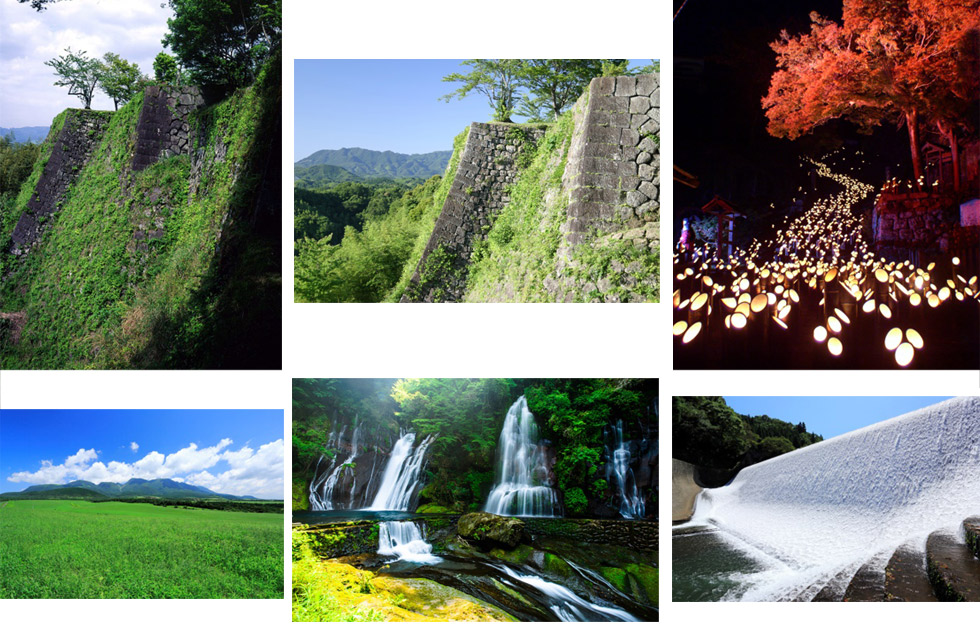
2. Themes of artistic expressions and worldview
There is a "boundary" between the past and future within the flow of time where everything follows natural laws that transcend our knowledge. Within the flow of time, the instance of now constantly moves to the past, while also pushing us to the future. We are not able to go back in time, as there is a rigid "boundary" between the past and future. This "boundary" can also be cruel at times.
I believe my awareness of "boundaries" within time was triggered after saying farewell to a close acquaintance when I was a student, as well as due to the terrorist attacks and earthquake disasters that occurred during that point in life. There is nothing we can do to resist this or to take back this time. What at first glance seemed to be the same flow of time shared between people actually turned out to be completely different timelines for each individual. Each of us faces a unique reality, which can be distressing and painful at times. Coming in contact with an acquaintance's passing and facing this reality left me overcome with a sense of loss, surprise, and confusion. Ever since, this topic became the core of my creations as a matter where I place a high degree of concern.
Up to my mid-twenties, my work expressed the negative aspects of time, such as its cruelty, pain, and sadness. However, one day a museum curator visiting my exhibition said, "Your artwork explores dark themes, but I also sense positive energy from your work." I did not expect a comment like this at all.
In contrast with the negative content which I had been consciously channeling into my art, I was reminded of the other side of the coin—my unconscious will to live, and my life force, which was naturally injected into my work. From that time onward, I actively started to create artwork with a positive message.
The "Boundary" series was born after this, when I came in contact with iron and stainless steel. Memories are engraved in the rust of iron, while the shiny surface of stainless steel reflects the current time. The mirror-like stainless steel holds hope as it reflects people's smiles, seasonal changes, and a bright future.
The "Boundary" artwork made me aware of "powers beyond human knowledge," the great laws of nature that transcends what humans believe is negative or positive within the flow of time. This gave birth to a work called "THE FORCE." This piece represents the shape of the instant something is freed from power (and represents this power), by taking a timber block about a height of a person and allowing it to crack under intense pressure of over 100 tons. An earthquake with a seismic intensity of 7 puts approximately 15 tons of pressure on a home, causing it to collapse, so you can see how intense the pressure is on the wood. There is no positive or negative in power itself. Nevertheless, some people see a positive side when light comes in through the cracks, or some may feel negative energy from the shape of the wood.
This work has its own continuity. I fill the cracks with materials that last longer than wood, and then I place the artwork outdoors. As the days go by, the wood will start to deteriorate and fall off, leaving the filler material representing energy in a pure form. It is almost like seeing a large power transform itself across time by natural forces, before appearing in front of us.
The "Boundary" and "THE FORCE" series were born in this way—I would like these artworks to be "living sculptures" that change with time, staying close to human lives and growing in harmony together with people.
Most outdoor sculptures that you see in towns or in parks are installed as desired at the time of their creation. However, as days and months go by, changes in time and the environment unfortunately necessitate many pieces to be reinstalled. Instead of fighting back against the natural flow of time, we need to give ourselves up to the changes that time brings and look from the past to the future to create artwork that connects the two together.
I believe it is my mission as a sculptor to express this concept in the world we live in today.
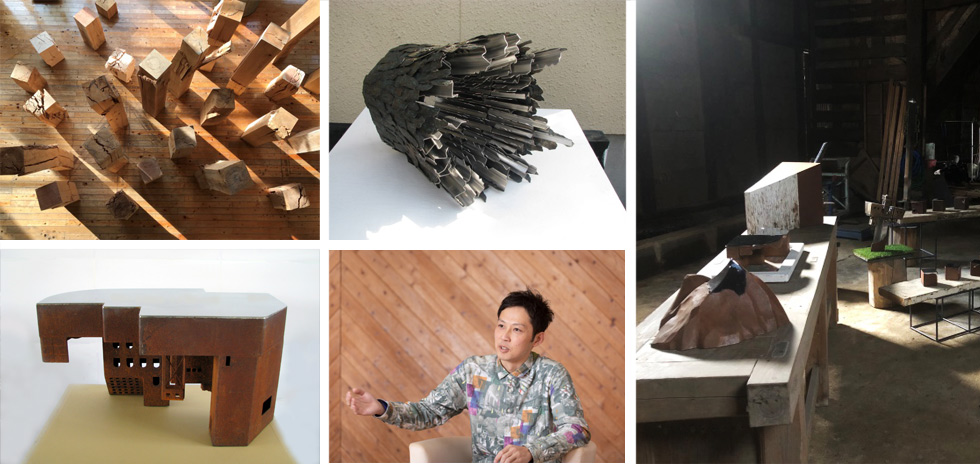
3. Discovering titanium/TranTixxii and expectations for this material
Iron, stainless steel, wood, and titanium—all of these materials have their own unique lifespan and relationship with time within the laws of nature. Titanium is a metal with a similar resistance to corrosion as precious metals, and it boasts a lifespan of well over 100 years—much longer than that of iron or stainless steel. On top of this, the designing titanium TranTixxii is a Japanese material not seen in any other country, and is a product which focuses on the long-lasting beauty of titanium.
I look forward to having TranTixxii bring further depth to my art when expressing the flow of time that transcends human knowledge, and I have started to challenge myself with new artistic expressions using the designing titanium TranTixxii brand.
From ancient times to the present day, the Japanese people have embraced the sorrows and blessings of the Japanese archipelago that houses a pool of natural energy. At times, we ready ourselves to revere powers that are beyond our comprehension.
There is a saying among the Japanese that we fear earthquakes, lightning, fires, and fathers, and there is an awareness that all things must pass. Along with Zen, tea ceremonies and other cultures nurtured in the country, the Japanese people have a deeply-rooted sense of reverence toward powers beyond human knowledge as well as toward the flow of time. At times, we have been in awe as we share the same flow of time, at the mercy of this type of power, while losses and tragedies have struck us in history. Just as we have accepted the powers of nature, it is no exaggeration to say that in current day, we have accepted the blessings and catastrophes created by scientific, man-made energy as well. I believe that the achievements made in basic science are in their own way manifestations of the interest and affinity that the Japanese people have toward the laws of nature.
Due to titanium's excellent and stable resistance to corrosion, it had been hiding within the earth's crust and rocks for an eternity. It was only discovered after humans came across electric energy. The supply of electricity in large amounts allowed for the mass-production of titanium after the war. This is a gift that was bestowed on us through this huge energy. Surprisingly, the Japanese people successfully ranked third in terms of mass production, following the Cold War era superpowers. We have focused on using this gift of massive energy for peaceful living, challenging ourselves to polish our aesthetics and philosophies to lead the world in our unique technological developments in the present day.
The designing titanium TranTixxii pursues beauty, and I believe that it is the result of this accumulation of time and that it connects our lives. It is more than just an industrial product or material—I hope it will serve as a brand that encompasses Japanese aesthetics, incorporates respect and awe toward the powers of nature, and faces power instead of turning away from it.
I look forward to new value produced through becoming intimate with powers beyond human comprehension and applying the potential of titanium as a material, as well as through creating harmony with the flow of time and making connections within the vast expanse of time.
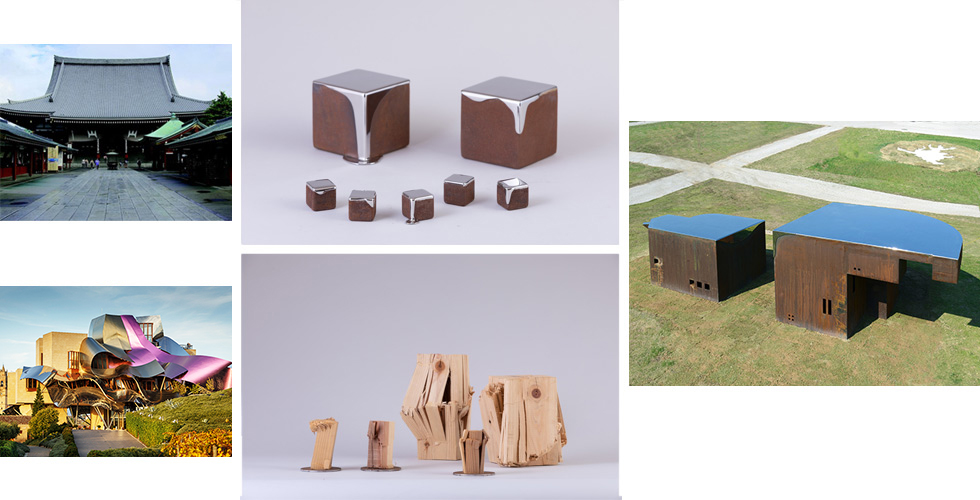
4. Future outlook and using TranTixxii for artistic expressions
Additionally, when compared to stainless steel—a metal that I have incorporated into my work for many years—titanium has a comparatively softer reflection and blends into the surroundings. I believe this is due to the color produced in a controlled manner through light interference in the designing titanium TranTixxii. This effect gives off a long-lasting impression of tranquility. In contrast to rust-prone iron and highly-reflective stainless steel, this material has a novel, markedly different atmosphere which I feel is incredibly attractive.
Titanium can be used in various environments, including locations that are exposed to seawater. It is light and strong, making it easy to transport. This removes any limitations on size and location, thereby creating infinite possibilities for artistic expression. It also demonstrates a striking affinity with living things, as it is also used in medical treatments such as manmade bones. As a matter of fact, I was impressed by how vegetation such as moss attached itself to the surface and blended into nature. I look forward to broadening the scope of expression, in ways never seen before with sculptures.
Furthermore, we cannot ignore the cutting-edge technology of the designing titanium TranTixxii. Its colors using the principles of light interference and it features blasting technology. These characteristics spurred me to imagine the possibilities for producing lasting marks on the surface of the metal through the creation process. When using materials with plasticity such as clay or paint in the world of art, marks from brushes, spatulas, or fingers serve as proof of originality; that our work is one-of-a-kind. Metals such as iron and stainless steel are rigid, and I believed that the only way to leave my mark on my creations was to use molding or weld beads.
In the world of designing titanium, the principles of color interference can be harnessed together with coating thicknesses and blast techniques to methods to create realistic depictions of nature. These methods are gradually being explored as people in the world of designing titanium build their experience with the material. By controlling the coating thickness and by creating obstructions on the titanium surface during blasting work to deliberately delay the process, I can evoke contrasting textures in the metal. I believe that the collaboration between Nippon Steel and architect Kengo Kuma that was released this year, featuring slats with surface patterns, is an application of this very principle.
Similarly, it is possible to create colored patterns by arranging an oil film (such as sebum, etc.) on the titanium surface in a fixed manner and controlling the coating thickness with electrical or thermal energy. I hope this method will allow many people to leave imprints (such as fingerprints) on artwork, thereby participating in the creation process. Furthermore, I believe that adding the world's first ever change-resistant color technology to the design titanium TranTixxii will allow these marks, along with other expressions, to maintain their original color for long periods of time. I would like to explore methods for new artwork so as to express "relationships between humans" and "fate" going forward, as these are also principles that transcend human comprehension.
As an artist who has created several outdoor sculptures up to this point, I feel I was destined to discover titanium. Titanium is perfect for "living sculptures." One of my goals is to create works of art to be installed outdoors that transcend human comprehension and connect us to the future with titanium.
It is said that the English word art comes from the Latin word ars. Ars originally means human techniques and technologies, and is placed as the antonym to nature. I want to use TranTixxii—created from a fusion of ars between Nippon Steel and partner corporations—to create artwork that will be passed down through generations. Through this, I seek to promote artwork and Japan's unique titanium throughout the world.
